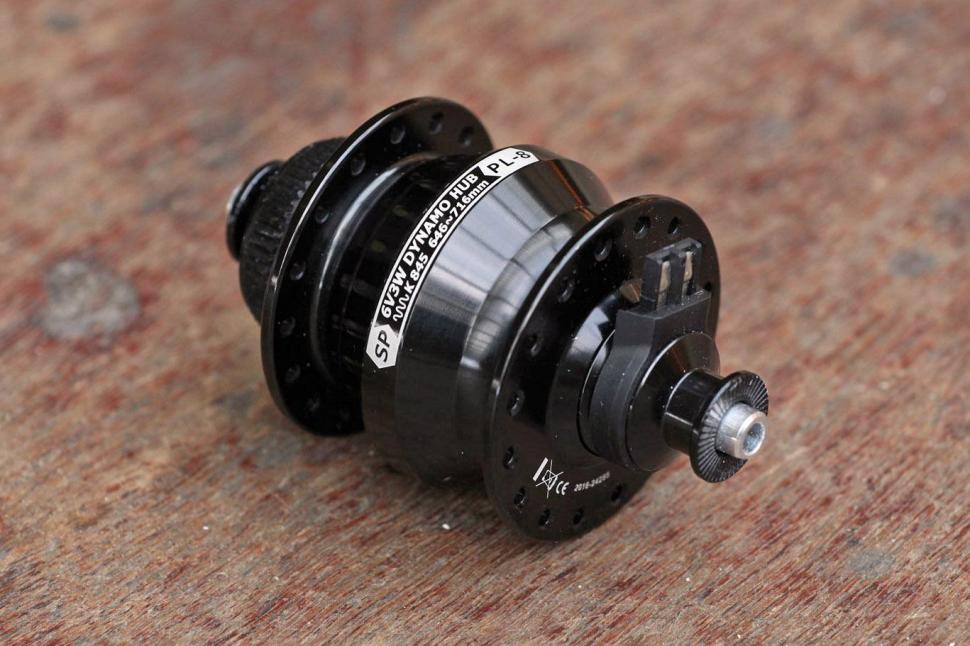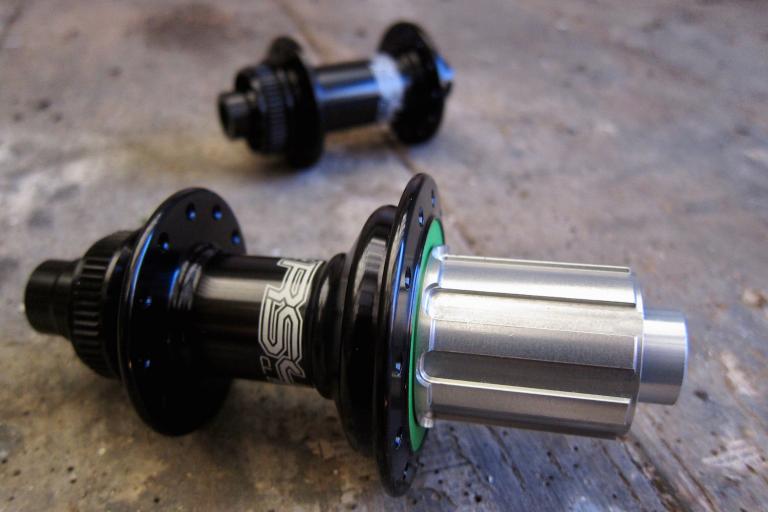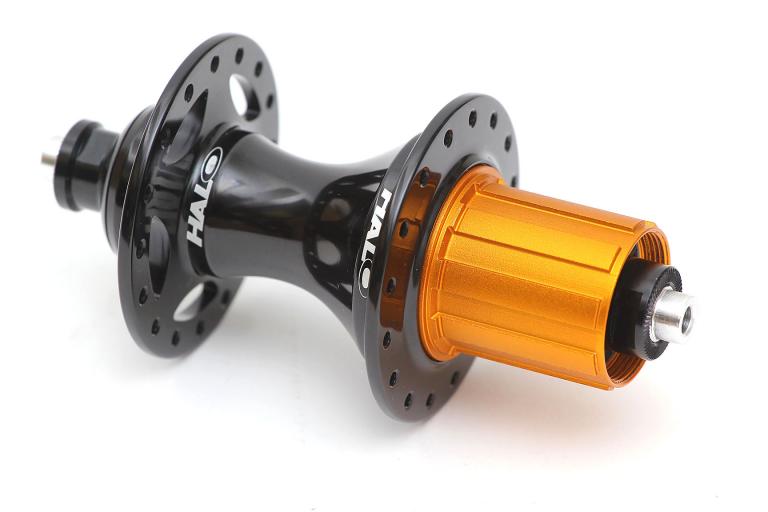- News
- Reviews
- Bikes
- Components
- Bar tape & grips
- Bottom brackets
- Brake & gear cables
- Brake & STI levers
- Brake pads & spares
- Brakes
- Cassettes & freewheels
- Chains
- Chainsets & chainrings
- Derailleurs - front
- Derailleurs - rear
- Forks
- Gear levers & shifters
- Groupsets
- Handlebars & extensions
- Headsets
- Hubs
- Inner tubes
- Pedals
- Quick releases & skewers
- Saddles
- Seatposts
- Stems
- Wheels
- Tyres
- Tubeless valves
- Accessories
- Accessories - misc
- Computer mounts
- Bags
- Bar ends
- Bike bags & cases
- Bottle cages
- Bottles
- Cameras
- Car racks
- Child seats
- Computers
- Glasses
- GPS units
- Helmets
- Lights - front
- Lights - rear
- Lights - sets
- Locks
- Mirrors
- Mudguards
- Racks
- Pumps & CO2 inflators
- Puncture kits
- Reflectives
- Smart watches
- Stands and racks
- Trailers
- Clothing
- Health, fitness and nutrition
- Tools and workshop
- Miscellaneous
- Buyers Guides
- Features
- Forum
- Recommends
- Podcast
review
£114.99
VERDICT:
Top performing dynamo hub at a very competitive price
Weight:
404g
Contact:
At road.cc every product is thoroughly tested for as long as it takes to get a proper insight into how well it works. Our reviewers are experienced cyclists that we trust to be objective. While we strive to ensure that opinions expressed are backed up by facts, reviews are by their nature an informed opinion, not a definitive verdict. We don't intentionally try to break anything (except locks) but we do try to look for weak points in any design. The overall score is not just an average of the other scores: it reflects both a product's function and value – with value determined by how a product compares with items of similar spec, quality, and price.
What the road.cc scores meanGood scores are more common than bad, because fortunately good products are more common than bad.
- Exceptional
- Excellent
- Very Good
- Good
- Quite good
- Average
- Not so good
- Poor
- Bad
- Appalling
Although Taiwan's Shutter Precision, or SP for short, only got into the hub dynamo game less than a decade ago, their hubs are some of the most popular amongst the audaxing/ultra-distance crowd. In addition to selling their hubs under their own brand, their hub design has also been licensed to numerous other (mainly light) manufacturers, such as Exposure and Supernova.
The 8 series is the workhorse of the SP range, having been continuously updated since its launch in 2011 as new brake types and axle diameters have been introduced. Today, the 8 series comprises seven different variants, with each available in 20, 24, 28, 32 and 36-hole drillings, catering to every type of current road hub, and most mountain bike hubs too.
If you're anything like me, the first thing you do when taking a new hub out of its box is give it a spin to check the bearings. I was shocked initially to discover how notchy the hub felt out of the box; indeed, it took quite a lot of force to get the thing to turn at all. This is resistance from the dynamo itself, the magnets and coils that generate electricity as you ride, and is entirely normal. Once built into a wheel and with the added inertia from the rim, the hub spins a lot more freely. Out on the road, you'd be hard pressed to notice any difference at all compared to a standard hub.
Installation is very easy, which is a good thing given the sparsity of instructions in the box. The hub uses a two-piece connector (the same as Shimano dynamo hubs) to join the contacts on the drive side of the hub to your lights, charger or whatever else you want to power. Although the connector parts are made from plastic and appear cheap and flimsy at first glance, in practice they work just fine. The only potentially tricky part of the installation process is stripping your light wires to expose the copper wire, but with a little care and attention this can be done using only a craft knife. The wires are then fed into one of the connectors (no polarity issues to deal with), which is then clicked into the second connector. That secures everything and ensures the wires are in the correct location to engage the contacts on the hub.
Buy SP PL-8 Dynamo Hub
Find a Shutter Precision dealer
Although it's not essential (I used the hub for over 1000km with the bare wires inserted into the connector), I ended up adding some solder to the wire ends, just to prevent them from fraying. This may be prudent if you're trying to run two sets of wires (from a light and a charger, for instance) in parallel. To do this, you simply twist the pairs of wires together and then insert into the connector as before. The fit is tighter when you do this, but it still works fine. To finish off, I added some heatshrink where the cables enter the connector, but again, this was done for peace of mind rather than necessity.
Claimed power loss with lights turned off is just 1W at 30km/h; in other words, negligible. Despite the initial notchy feel the extra resistance compared to a conventional hub is completely unnoticeable. With the lights on, the rated efficiency is 73% at 15kph, dropping to just under 50% at 30kph. This doesn't sound great, and it's probably worth turning your lights off or disconnecting your charger on a long ride, but it's about the best that current dynamo technology has to offer. In practise, the 3W output will easily be enough to power a front & rear light pair that will let you ride at full speed on unlit roads. If charging a power hunger device such as a mobile phone simultaneously, the lights do dim significantly so some planning around that is still required.
Dynamos will never grace the bikes of true weight weenies, but the PL-8 is pretty light at 404g. A typical good quality Center Lock front hub like a Shimano Ultegra CX75 weighs 166g, but the 238g extra for the PL-8 is less than the weight of the battery pack you'll be leaving at home. Our measured weight is only 4g than the claimed weight – well done SP for being honest.
Durability is also a key consideration when purchasing a dynamo hub, which will likely see much use over the, shall we say, less pleasant parts of the year. There are reports of customers having problems with the bearings in SP hubs, but I had no issues during my time on them. Whether that's due to improved quality or just luck in my case, is hard to say. In any case, over the testing period, I've put in nearly 10,000km on this hub, including half of the Transcontinental, without any problems with the bearings or any other part of the hub. In the case that they do fail, the hub will have to be sent back to SP for replacement – standard procedure for dynamos which require quite exacting calibration when re-assembling.
SP markets the performance – efficiency and weight – as the key selling points of the 8 series. However, price is also a significant differentiator as it undercuts SON, the defacto gold standard among hub dynamos, by around half. Given this, the PL8 (and the rest of the 8 series) presents great value for anyone looking for performance without breaking bank. On a personal level, I'm sold on the utility of dynamo hubs, the PL-8 in particular, and will be getting one for my next wheelset.
Verdict
Top performing dynamo hub at a very competitive price
road.cc test report
Make and model: SP Dyno Hub PL8 CL-DB 32H 8LK
Size tested: 32 H
Tell us what the product is for, and who it's aimed at. What do the manufacturers say about it? How does that compare to your own feelings about it?
The PL-8, and the rest of the 8 series, is an ideal dynamo hub for anyone after a high performance dynamo hub, without the price tags that the top of the range SON dynamos command. According to SP, "The SP 8-series hub dynamo incorporates the best technical advancements and seeks to attain perfection in field of hub dynamos." Quite a claim! I'm not sure if it's quite got there, but it's certainly a great option.
Tell us some more about the technical aspects of the product?
6V, 3W dynamo hub available in a wide range of axle diameters, brake types and spoke hole counts. For full specs of the whole 8 series range, visit the SP website. A 2 part plastic connector (Shimano style) is used to connect to lights and other electric devices.
The model tested in this particular review was the 32h PL-8 - the centrelock disc brake version.
Rate the product for quality of construction:
8/10
The SP hub is well manufactured and finished - it looks the part, although it can't quite match the top-of-the-range SON dynamos for appeal.
Rate the product for performance:
9/10
Does exactly what you'd want from a dynamo, without complaint. So far, over nearly 10,000km, the PL-8 hasn't missed a beat. Based on the numbers (both SP's own and independent tests), the 8 series are one of the most efficient and light weight dynamo hubs currently available.
Rate the product for durability:
8/10
There have been historical issues with bearings in some of the 8-series hubs (15mm axle ones in particular, it seems), but my experience over the test period has been nothing other than exemplary. I'm looking forward to another 10,000km of issue-free riding with light and charging power at the flick of a switch.
Rate the product for weight (if applicable)
9/10
At 404g (400g claimed), it's one of the lightest hub dynamo out there.
Rate the product for value:
9/10
At half the price of a SON, and with similar weight and efficiency, the 8-series is excellent value. It might not quite have the cachet of the German brand, but for those on more of a budget, it's a great option.
Tell us how the product performed overall when used for its designed purpose
Excellent dynamo with class-leading efficiency, perfect for the long distance cyclist and the seasoned commuter alike.
Tell us what you particularly liked about the product
Fit and forget installation. That it's theoretically one of the most efficient hubs out there is an added bonus when putting in the long miles.
Tell us what you particularly disliked about the product
Plastic connector doesn't feel all that solid. That said, it hasn't missed a beat in practice.
Did you enjoy using the product? Yes
Would you consider buying the product? Yes, in fact, I'll be getting one for my next wheelset
Would you recommend the product to a friend? Yes
Use this box to explain your score
Excellent performance at a great price and, so far, it's proving to be durable as well. The PL-8 is a great option for those after a high-spec dynamo without breaking the bank
About the tester
Age: 24
I usually ride: Giant TCR My best bike is:
I've been riding for: 5-10 years I ride: Every day I would class myself as: Semi pro
I regularly do the following types of riding: road racing, time trialling, cyclo cross, commuting, touring, mtb,
For 5 years, racing was my life and I went all the way from a newbie bonking after 40 miles, to a full-timer plying my trade on the Belgian kermesse scene. Unfortunately, the pro dream wasn't meant to be and these days, you're more likely to find me bimbling about country lanes and sleeping in a bush on the side of the road.
Latest Comments
- Secret_squirrel 2 sec ago
Yet you clearly do need perspective - its all over your response. It tells you that 40 cars passed you safely but yet you've been triggered by...
- mdavidford 7 min 57 sec ago
I can't imagine carrying that Lion of Flanders flag round with him helped Van der Poel much either.
- Hirsute 20 min 6 sec ago
I'd find a physio who would have a look. They will do tests to determine where the issue lies, the extent of mobility and maybe some exercises....
- mctrials23 21 min 58 sec ago
You dope and you lose the jerseys. Its as simple as that. There are plenty of valid points to be made about cycling at the time and the prevalence...
- Simon Withers 25 min 25 sec ago
Absolutely - I'm a big fan of sub-compact chainsets, which can help you get a low gear even without a very large sprocket. Your 46/30, 11-34 combo...
- Miller 25 min 56 sec ago
An uh-oh email signifying that it took Tadej Pogacar to dethrone you, that's pretty impressive. You'd want to keep that email.
- Rendel Harris 41 min 41 sec ago
I wouldn't mind, but I would like the caveat that it should come after I've enjoyed at least one post-ride pint of beer. Sure many others have...
- Backladder 46 min 33 sec ago
It was a bit of a tongue in cheek suggestion
- chrisonabike 1 hour 46 min ago
The thing we're envious of over here in the UK is ... any largely motor vehicle-free area (still not normal for UK). Never mind one with formal...
- OnYerBike 1 hour 59 min ago
Thank you for this detailed and insightful contribution.







Add new comment
10 comments
^ that "lucky dip" element persuaded me to dig deeper and buy a SON for my wheel build.
One of my SP hubs has done about 20,000 km my other lasted about 1000km. Have a look on the Bearbones bikepacking forum and see how people have got on. It's a lucky dip if you get one that lasts. I got a new one through warranty which was nice but I'll buy a Son next time.
Glad to see a review of a dyno-hub and especially a review where the reviewer has used the product extensively and reported on that. Overall a useful review and I'd agree with the conculsions having used an Exposure branded version of the SP hub on my commute/touring bike.
A couple of minor points: it might have been helpful to explain the notchiness of the hub when the axle is turned by hand as otherwise it might look like an issue - the notches are simply magnetic and as the axle turns it is effectively pulled one way by the magnetic force and then pushed the opposite way so there is no impact on energy required and the bearings are turning smoothly. Also the rated efficiency at various speeds referred to in the review isn't explained.
I see on the comments that Random Rouleur mentioned the Igaro D1 convertor and wonder if a review of such devices might be possible or welcomed in the future?
Timely review, got my eye on the thru axle version with a B&M headlight
Using mine with a Cyo Premium Senso T - perfect for the unlit roads around here. Hooked into a Line Plus rear light. Not entirely sure I need the daylight running lights on the T but I've certainly had less close passes since riding with the rear light. I think from a distance I look more like a motorbike which may help
Would be worthwhile doing a review of the Igaro D1 convertor, which works excellently with this hub and hubs like it (e.g. SON 28). It blows away all the competition in terms of efficiency and power, allowing for easy recharging of USB devices as well as running lights etc.
https://www.igaro.com/d1
BTW, I've no affiliation to Igaro at all - just a very happy customer. Delighted to see a small British company innovating...
That Igaro website is peculiar, it completely fails to explain how to install the system. Pictures of devices with wires everywhere and not an explanation of where they go. Then their instal kit assumes you dont have a dynamo light ?!?!?! really? Id assume 90%+ of people with a dynamo have it for a light. Its such a simple process wiring it in, i dont understnad how they havnt done it.
Two of the three available power leads have connectors for lights (you choose which lead based on your dynamo hub type). There's also a switch with a second output for a light and for it two light leads (one for Exposure Revo) are available.
Installation instructions? https://www.igaro.com/d1/installation
I've run a disc version of this for a couple of years with no issues. Good product.
I've got the Exposure version of this with the 15mm thru-axle option. 3 years and counting of winter riding, it's now on its second light.
If you're buying one I would say go for 15mm thru (slightly more expensive) in the interest of future-proofing as its convertible down to both 12mm thru and 9mm QR. They include the QR axle with the hub, and you just need an inexpensive sleeve to go from 15 to 12.
Having just swapped from 15mm thru to QR I've had no issues with the hub other than the usual lawyer lip incoveniences.
If you're running a light from B&M which has pass-thru connectors built into the light polarity is important if you also want to power a rear light. The Shimano-type connector has earth labelled and you need to connect the same wire (on B&M lights its the one with the white stripe) to earth throughout. I've always set mine up with the earth wire connected to the right hand connector on the hub.